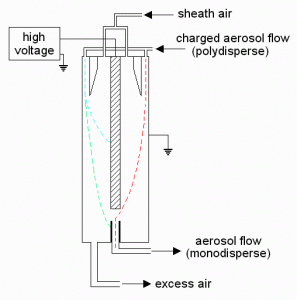The Differential Mobility Analyzer (DMA) is a device that can be used to sort submicrometer aerosol particles according to size while keeping them suspended in air. The first step in this technique is to apply an electric charge to the particles. It is difficult to put more than one charge on small particles; as a result, most of the particles will be either uncharged or have a single charge. Only the positively charged particles are sorted by the DMA; all of the others are lost.
After charging, the particles enter the DMA were they are allowed to migrate into a clean sheath air flow under the influence of an electric field.  The rate of migration depends on the electrical mobility of the particles; mobility, in turn, depends on both the size and electrical charge of the particle. If all the particles have the same charge, then particles of a given mobility will all be of the same size. Since the particles migrate at different rates, they are spread out through the sheath air according to mobility. Then withdrawing a portion of the sheath air flow separates a narrow range of particle mobilities from the rest of the aerosol. To measure a size distribution, the differential mobility analyzer (DMA) is scanned over a range of particle mobilities by varying the applied field, after this is done the number concentrations in each range of mobilities are measured. These measurements can then be converted to a size distribution by using the distribution of charges produced by the charger and the known relation between mobility and size.
The rate of migration depends on the electrical mobility of the particles; mobility, in turn, depends on both the size and electrical charge of the particle. If all the particles have the same charge, then particles of a given mobility will all be of the same size. Since the particles migrate at different rates, they are spread out through the sheath air according to mobility. Then withdrawing a portion of the sheath air flow separates a narrow range of particle mobilities from the rest of the aerosol. To measure a size distribution, the differential mobility analyzer (DMA) is scanned over a range of particle mobilities by varying the applied field, after this is done the number concentrations in each range of mobilities are measured. These measurements can then be converted to a size distribution by using the distribution of charges produced by the charger and the known relation between mobility and size.
When the monodisperse (equal size) particles leave the DMA they are still suspended in air. A number of things can be done with these particles. They can be used as a reagent in an experiment; for example, kinetics experiments on the rates of reactions between gases and particles. They can be subjected to a change in conditions to see how they change; for example, they can be heated to determine how volatile they are. They can be subjected to chemical analysis to determine their composition. Or they can simply be counted to determine the concentration of particles as a function of size; this provide the size distribution of the aerosol entering the DMA.
Particles with diameters as small as 3 nanometers can be detected and counted using a condensation nucleus counter (CNC). In this device, a liquid, such as butyl alcohol, is condensed on the particles so that they grow to a diameter of about a micrometer. They are then large enough to scatter an appreciable amount of light. Then, by passing these particles through a beam of light, flashes of light are produced. These flashes can be detected and counted to determine the concentration of particles in the flow entering the CNC.
